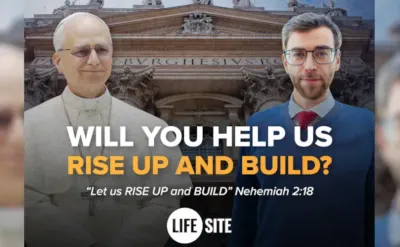We used to know that double suicides are double tragedies. Legalizing assisted suicide changes that. We must glamorize it, so that we can live with ourselves.
(LifeSiteNews) — I am old enough to remember when the reaction to double suicides was still horror, or hushed solemnity.
Those days are over. Now that “assisted suicide” is championed as a fundamental human right – at least, for those pre-selected as eligible by the state – we must pretend that double suicides are not tragic at all. Rather, they are a glorious expression of autonomy, a Very Appropriate Ending to full lives and entrancing love stories.
If the activists at Dying with Dignity and similarly sinister organizations get their way, “happily ever after” will soon involve lethal injections and longing looks overseen by the doctor who dispatched the couple.
As the United Kingdom considers legalizing assisted suicide, the pro-suicide propaganda has been ramped up. Dignity with Dying went so far as to plaster the subway stations with ads showing happy, attractive people welcoming suicide with big smiles:
READ: Assisted suicide advocates choose to die through euthanasia
But far more insidious are stories like this June 7 report in the Guardian, titled “When they chose to die together, my grandparents wrote the final chapter of a love story spanning 70 years.” Labour MP Kim Leadbeater, the parliamentarian currently attempting to legalize assisted suicide in the U.K., promptly posted it with a heart emoticon and the hashtag #ChoiceAtTheEndofLife. The lede paragraphs set the tone:
In their final moments, Ron and Irene lay together in a single bed, soft smiles on their faces. They wore special shirts picked out for the occasion; his a cranky cockatoo print, and hers the same white and floral print blouse she wore to their 70th wedding anniversary a few months previously.The only sign of what was to come were the twin cannulas, one in each of their intertwined hands, with long thin tubes winding back behind the beds and out of sight.
It had felt like an eternity to get here – the reality closer to three weeks – with countless possible pitfalls. But it was about to happen. Ronald and Irene were about to get their final wish; to die peacefully together.
The story goes on to describe their wonderful marriage; their declining health in old age; their application for assisted suicide in Australia together; the festive celebration as the couple prepared for “their last adventure together.” And then:
Both my grandparents chose to die via medical assistance, rather than self-administer, requiring four medical personnel in the room. The two doctors shepherded us through the process with an endless amount of patience, empathy and care. They gently told us it was time, and Irene laid down next to Ron on the bed. The cannulas went in, the cords winding back and away, so the doctors could step back and allow us to be by their sides…And then it happened. Calmly, quickly, with dignity. In a room full of love, with smiles on their faces and without any pain. We’d been told that hearing was the last sense to go, so we repeated, "I love you, I love you, I love you,” until we were sure that they’d finally slipped away.
READ: Pope Leo XIV urges respect for life as France moves to legalize assisted suicide
The complicated grief of the family who said goodbye when they could have had more time shines through, despite the sheen their granddaughter tries to put on this double suicide.
Her prose is powerful, but I cannot help feeling sick as I read. The logic of assisted suicide looms over the events: that to die with dignity, these two elderly people had to die faster. That assisted suicide will always be headstrong people insisting on their own way, rather than vulnerable people being preyed upon by a system that has a specific view on what “dying with dignity” means.
Other elderly people might read a story like this and get the picture. Once you become old; once your body begins to break down; once you become a burden to those around you – you should consider applying for a suicide, because it is a beautiful way to go. The myth of true autonomy pervades the piece – you are not dying at the end of a lethal injection, but “writing the final chapter of your own love story.”
The trend of “double euthanasia is growing”; on February 5, 2024, the former Dutch Prime Minister Dries van Agt died by lethal injection with his wife in his hometown of Nijmegen. They are not the only ones:
One particularly high-profile case featured a healthy U.K. couple, and the former prime minister and his wife may be part of a trend. As the New York Post reported: “Duo euthanasia, or two people receiving a fatal injection simultaneously, is still relatively rare in the Netherlands but is slowly gaining more popularity … Twenty-nine couples opted for the paired death in 2022, up from 16 who chose it in 2021 and the 13 pairs the year before.” In 2018, a Canadian couple opted for ‘duo euthanasia’; they did cheery interviews about the decision scarcely a week before they died by lethal injection, also hand in hand.
We used to know that double suicides are double tragedies. Legalizing assisted suicide changes that. We must glamorize it, so that we can live with ourselves.

